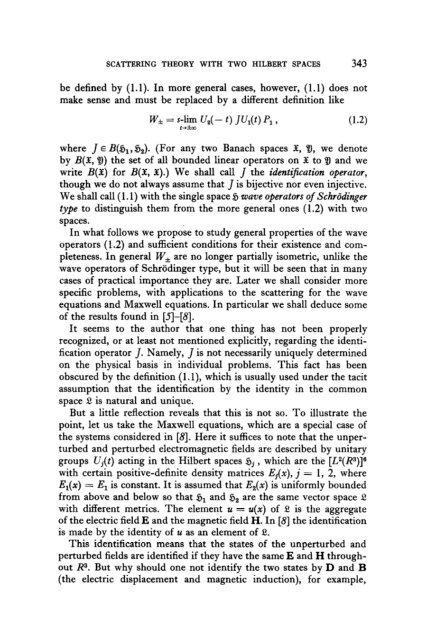On the Characters and the Plancherel Formula of Nilpotent Groups ...
On the Characters and the Plancherel Formula of Nilpotent Groups ...
On the Characters and the Plancherel Formula of Nilpotent Groups ...
Create successful ePaper yourself
Turn your PDF publications into a flip-book with our unique Google optimized e-Paper software.
SCATTERING THEORY WITH TWO HILBERT SPACES 343<br />
be defined by (1.1). In more general cases, however, (1.1) does not<br />
make sense <strong>and</strong> must be replaced by a different definition like<br />
where J E B(ljl,-tF2). (F or any two Banach spaces X, 9, we denote<br />
by B(x, 9,) <strong>the</strong> set <strong>of</strong> all bounded linear operators on X to 9 <strong>and</strong> we<br />
write B(X) for B(x, w).) We shall call J <strong>the</strong> identification operator,<br />
though we do not always assume that J is bijective nor even injective.<br />
We shall call (1.1) with <strong>the</strong> single space $j wave operators <strong>of</strong> Schriidinger<br />
type to distinguish <strong>the</strong>m from <strong>the</strong> more general ones (1.2) with two<br />
spaces.<br />
In what follows we propose to study general properties <strong>of</strong> <strong>the</strong> wave<br />
operators (1.2) an d su ffi cient conditions for <strong>the</strong>ir existence <strong>and</strong> completeness.<br />
In general IV, are no longer partially isometric, unlike <strong>the</strong><br />
wave operators <strong>of</strong> Schrodinger type, but it will be seen that in many<br />
cases <strong>of</strong> practical importance <strong>the</strong>y are. Later we shall consider more<br />
specific problems, with applications to <strong>the</strong> scattering for <strong>the</strong> wave<br />
equations <strong>and</strong> Maxwell equations. In particular we shall deduce some<br />
<strong>of</strong> <strong>the</strong> results found in [5]-[S].<br />
It seems to <strong>the</strong> author that one thing has not been properly<br />
recognized, or at least not mentioned explicitly, regarding <strong>the</strong> identification<br />
operator J. Namely, J is not necessarily uniquely determined<br />
on <strong>the</strong> physical basis in individual problems. This fact has been<br />
obscured by <strong>the</strong> definition (l.l), which is usually used under <strong>the</strong> tacit<br />
assumption that <strong>the</strong> identification by <strong>the</strong> identity in <strong>the</strong> common<br />
space 2 is natural <strong>and</strong> unique.<br />
But a little reflection reveals that this is not so. To illustrate <strong>the</strong><br />
point, let us take <strong>the</strong> Maxwell equations, which are a special case <strong>of</strong><br />
<strong>the</strong> systems considered in [S]. Here it suffices to note that <strong>the</strong> unperturbed<br />
<strong>and</strong> perturbed electromagnetic fields are described by unitary<br />
groups Ui(t) acting in <strong>the</strong> Hilbert spaces Bj , which are <strong>the</strong> [L2(R3)lS<br />
with certain positive-definite density matrices Z$(x), j = 1, 2, where<br />
E,(x) = El is constant. It is assumed that E,(x) is uniformly bounded<br />
from above <strong>and</strong> below so that 5, <strong>and</strong> $s are <strong>the</strong> same vector space B<br />
with different metrics. The element u = U(X) <strong>of</strong> 2 is <strong>the</strong> aggregate<br />
<strong>of</strong> <strong>the</strong> electric field E <strong>and</strong> <strong>the</strong> magnetic field H. In [S] <strong>the</strong> identification<br />
is made by <strong>the</strong> identity <strong>of</strong> u as an element <strong>of</strong> 2.<br />
This identification means that <strong>the</strong> states <strong>of</strong> <strong>the</strong> unperturbed <strong>and</strong><br />
perturbed fields are identified if <strong>the</strong>y have <strong>the</strong> same E <strong>and</strong> H throughout<br />
113. But why should one not identify <strong>the</strong> two states by D <strong>and</strong> B<br />
(<strong>the</strong> electric displacement <strong>and</strong> magnetic induction), for example,

















